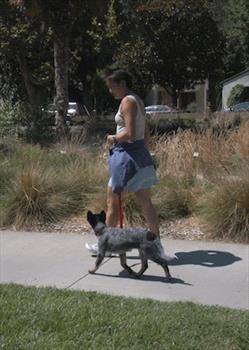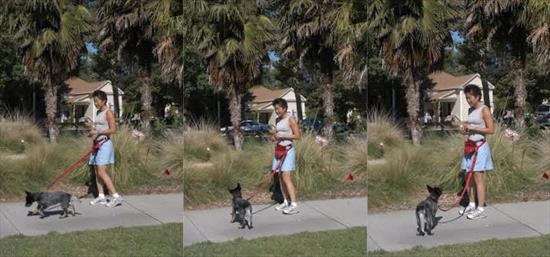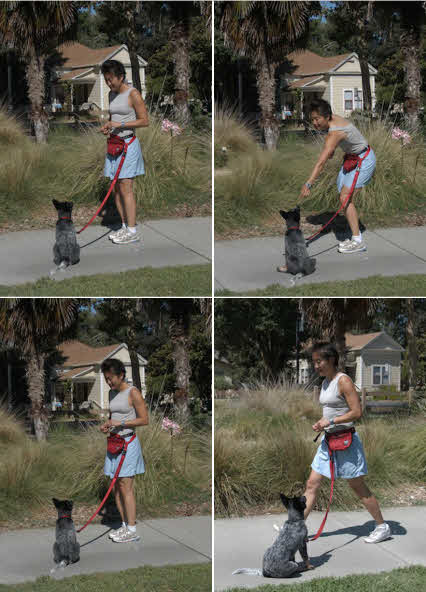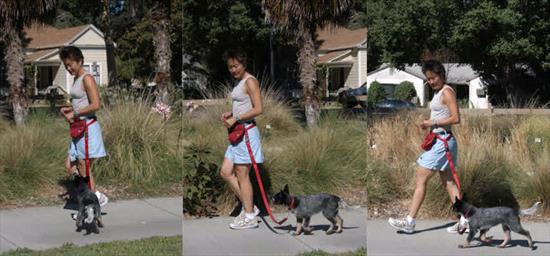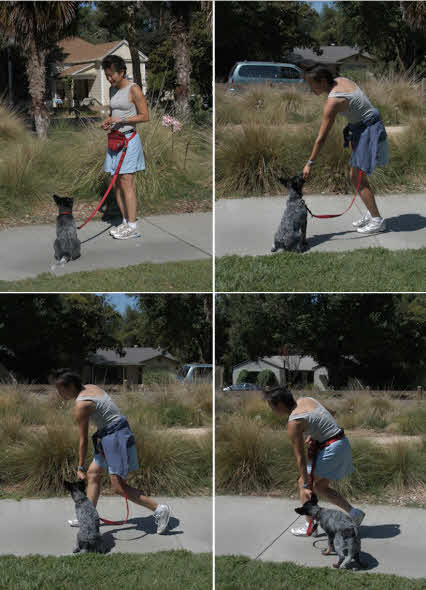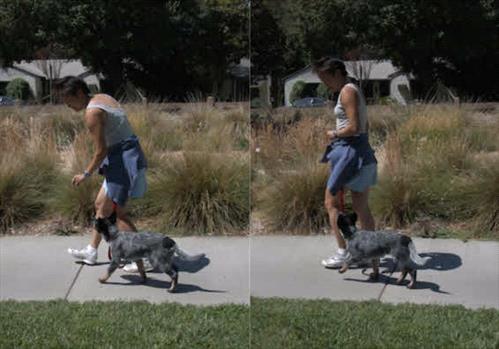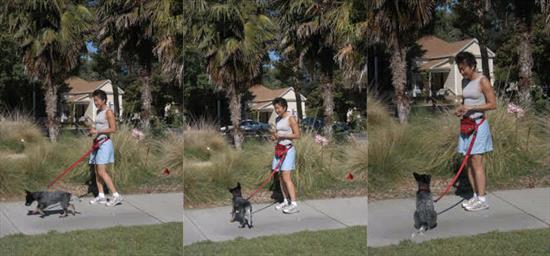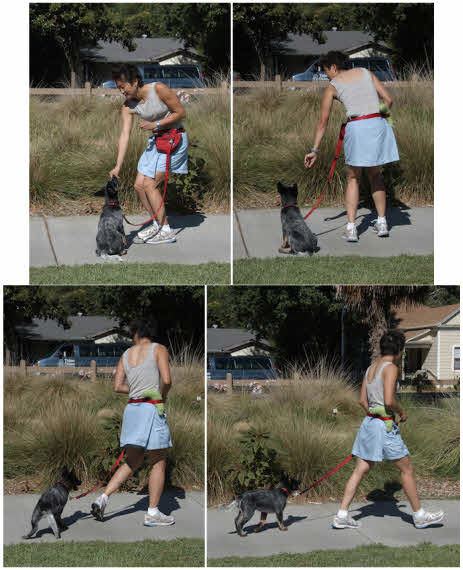You’ve probably heard the talk about how humans with dogs are healthier because they exercise more. A number of scientific studies support this statement; however, what those articles fail to mention is that if your dog drags you, lunges, or tangles you in the leash, those walks may not be that fun. To improve your dog’s behavior and the enjoyment for both of you, here are a few tips on training your puppy or adult dog to walk at your side.
Why do dogs pull on leash?
First, it’s important to know that dogs pull on leash because it gets them where they want to go, faster. As a result, if we want them to walk on loose leash, we need to stop dead in our tracks if they start to pull and only walk forward when they are on a loose leash. Of course, this sounds simple but getting it right can be a little tricky. Here’s how to get this approach to work.
Where should your dog be?
Before you even start, it’s essential that you choose a specific zone where your dog should walk in relation to you. I recommend your dog walk by your right or left side with his shoulders even with yours, like your friend or a human companion would. That’s the location where you can communicate with Fido most easily. This position is often referred to as heel position. It’s also okay if your dog chooses to walk a little behind you.
Preparing to start the walk
Start with your dog seated next to you on your chosen side. Give one treat for sitting and additional treats, if needed, for remaining seated so he doesn’t get up before you’re ready to walk forward. As Fido gets better at holding his sit position next to you, increase the interval between treats and also vary the interval so that you can eventually fade the treats out for this calm start behavior.
Choose the right walking pace
Next, start walking. You probably never thought you needed a lesson in walking but it turns out that most people do. If we want dogs to follow our lead and stick with us, we have to walk in a manner that makes it clear we know where we’re going. That means we should generally walk at a brisk enough pace to keep our dog at a fast trot. Incidentally this is also a much better pace for helping to burn calories in both you and your dog. What do I mean by brisk? 120 beats per minute (bpm) or faster (two steps per second). And if you have an energetic Jack Russell Terrier, like my dog, Jonesy, you may have to walk at 130 or 135 bpm to keep him happy so he thinks his walk with you is fun rather than acting like you’re his ball and chain.
You can even experiment with your pace at home. See how fast you need to walk to get your dog at a fast trot. Then watch his demeanor at that pace and compare it to his demeanor, attention and focus when you walk more slowly. The average dog is more likely to respond to the slower speed by stopping to sniff, marking more frequently, and focusing on or pulling towards animals, people or objects in the environment. That’s because, compared to his human, the environment now looks more interesting.
Reward your dog when he’s trotting at your side and focused on you
Once you’ve started and are walking at a brisk pace, give your dog treats (ideally portions of his daily meal) every time he’s heeling next to you and looking at you for 2–3 steps. As soon as you can get him to repeat this focused behavior 5 or more times in a row, increase the number of steps he must heel and focus on you to 4–5. Next, alternate between a higher interval of focused behavior between treats, such as 7–10 steps, and a lower interval, such as 1–5 steps. The goal is that by increasing the expectation but rewarding her frequently enough, Fido learns it’s fun to trot by your side while focusing on you and she doesn’t even try to pull ahead.
At first, I practice this focused heeling through the dog’s entire walk because, at first, many dogs need to be looking at you in order to remain at your side. But once Fido can walk at attention for half to an entire block, she will most likely stick by your side even when she’s not looking at you, at least in low distraction walks. At that point, your dog can be allowed to walk at your side without needing to look at you; however, still only reward him when he heels at attention.
You must make it clear that pulling doesn’t work
Most dogs will want to forge or lunge ahead at some point in their walk even if you’re rewarding with treats for heeling politely. That’s why it’s equally important to make it clear that if Fido gets ahead of you, and especially if he pulls on leash, he is going nowhere. When Fido gets even one paw ahead of your foot, just stop within a split second so that, by the time he gets to the end of the leash, you’re stationary. By doing so, you make it clear to him that he doesn’t get to pull, even once. If you don’t stop this behavior abruptly or you have the leash in your hand and let your dog pull your arm forward then he instead learns that he can pull a little or pull sometimes. This sends him mixed messages and prevents him from learning that walking on loose leash is what works. It’s also one reason I generally recommend a hands-free leash such as the Buddy System.
Once you’ve stopped, you must wait for Fido to come back and look at you such that the leash is hanging in a loose U. Now for the really tricky part of this formula. Once you’ve stopped you must wait for Fido to come back and look at you. At first when Fido gets to the end of the leash he may pull a little bit, but if you’ve worked on other exercises that I commonly recommend, such as “say please by sitting” (ch. 5 in Perfect Puppy in 7 Days) and the version of leave-it where we toss treats to the end of the leash (ch 5), then Fido will remember that pulling never works. In fact, on a walk, pulling causes the walk to suddenly become really boring. Then, if you’ve been careful about standing stationary, he’ll remember that he should come back to you and say please by sitting in front of you in order to get you to provide rewards—such as treats and, ultimately, walking forward.
Once your dog sits in front of you, reward her with one treat for sitting and additional treats for remaining seated and focusing on you if needed. The additional treats are to train her to remain focused on you instead of falling into a habit of taking one treat and then blowing you off. The better she gets at focusing on you in the sit, the longer and more varied the treat interval should be. You can walk on when Fido’s sitting calmly in front. Sometimes you should wait for her to sit and look at you for 2 seconds after her last treat before you walk on. Other times you can give her last treat and start walking right after the handoff.
Resume your walk at a brisk pace (> 120 bpm)
It’s essential that once you do start walking, you walk at a brisk pace. That way you send a clear signal to your dog that you are resuming the walk. He needs to see a clear and immediate difference between the two paces. Cues, such as the speed at which you move, are important if you want to communicate clearly what you want to your dog.
What if your dog is already ahead of you on the first step?
Some dogs get up quickly as soon as you start walking and you can’t catch up to them to get beside them so that they are in heel position. This is more likely to occur if you walk too slowly. But, in any case, here are two solutions to keep Fido from immediately starting off ahead.
Solution 1: Distract and reward with a treat.
Start walking as you are giving her a treat while she’s sitting. That is, your left hand (if she heels on the left) will be holding the treat at her mouth, thus keeping her occupied as you start to walk past her.
Then, once you are beside her, let go of the treat so that she can eat it and get up and walk next to you. Now she is in heel position next to you. Repeat this method a handful of times and then try it without the treat distraction as you start. Then use the distraction technique only when you need it, until sitting and waiting for you to move up to Fido’s heel position before walking becomes a habit for her.
Solution 2: Head in the opposite direction after Fido sits
In this method, once Fido’s sitting and focused on you, turn around and walk the opposite direction.
Again, stand stationary if she’s even about to pull. Wait for her to figure out that as long as she pulls she will go nowhere. When she magically turns and sits facing you, reward her with a treat within a split second.
Then head in the new direction. You may have to lure her when you start to walk in the new direction so that she knows to stay on your left side (if you’ve chosen the left side for heeling). Note that when she consistently turns to come back to you immediately upon getting to the end of the leash (e.g., she turns back within half a second), you can head in the other direction without giving her a treat or waiting for her to sit and just reward her by walking on in the other direction. Then you can vary it so she never knows which time she’ll get a treat for the good behavior. Ultimately you won’t need to give treats.
So, there it is, the basics to getting your dog to walk on a loose leash. Start in a relatively low distraction environment where you dog will not need to bark at or lunge to get to people, dogs or objects. Then work in increasingly distracting situations when Fido’s ready.
Of course, that’s not all there is to walking on loose leash. For more pointers, stay tuned for the blogs on other walking patterns to help teach your dog to stay at your side.


